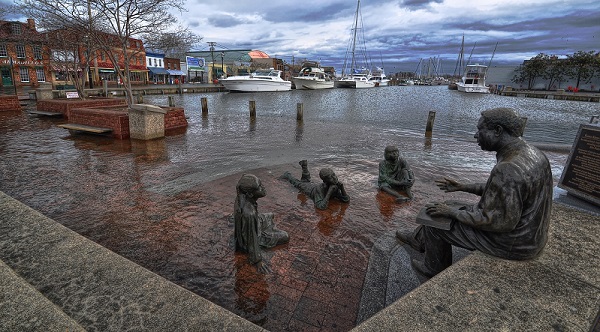By 2050, a majority of U.S. coastal areas are likely to be threatened by 30 or more days of flooding each year due to dramatically accelerating impacts from sea level rise, according to a new NOAA study, published today in the American Geophysical Union’s online peer-reviewed journal Earth’s Future.
The findings appear in the paper From the Extreme to the Mean: Acceleration and Tipping Points for Coastal Inundation due to Sea Level Rise, and follows the earlier study, Sea Level Rise and Nuisance Flood Frequency Changes around the United States, by the report’s co-author, William Sweet, Ph.D., oceanographer at NOAA’s Center for Operational Oceanographic Products and Services (CO-OPS). The new analysis was presented at a news conference today at the annual AGU fall meeting in San Francisco.
 Annapolis, Maryland, pictured here in 2012, is one of three major East Coast urban areas already being faced with nuisance flooding in excess of 30 days per year. (Credit: Amy McGovern.)
Annapolis, Maryland, pictured here in 2012, is one of three major East Coast urban areas already being faced with nuisance flooding in excess of 30 days per year. (Credit: Amy McGovern.)
NOAA scientists Sweet and Joseph Park established a frequency-based benchmark for what they call “tipping points,” when so-called nuisance flooding, defined by NOAA’s National Weather Service as between one to two feet above local high tide, occurs more than 30 or more times a year.
Based on that standard, the NOAA team found that these tipping points will be met or exceeded by 2050 at most of the U.S. coastal areas studied, regardless of sea level rise likely to occur this century. In their study, Sweet and Park used a 1½ to 4 foot set of recent projections for global sea level rise by year 2100 similar to the rise projections of the Intergovernmental Panel for Climate Change, but also accounting for local factors such as the settlement of land, known as subsidence.
These regional tipping points will be surpassed in the coming decades in areas with more frequent storms, the report said. These tipping points will be also be exceeded in areas where local sea levels rise more than the global projection of one and half to four feet. This also includes coastal areas like Louisiana where subsidence, which is not a result of by climate change, is causing land to sink below sea level.
NOAA tide gauges show the annual rate of daily floods reaching these levels has drastically increased – often accelerating – and are now five to ten times more likely today than they were 50 years ago.
“Coastal communities are beginning to experience sunny-day nuisance or urban flooding, much more so than in decades past,” said Sweet. “This is due to sea level rise. Unfortunately, once impacts are noticed, they will become commonplace rather quickly. We find that in 30 to 40 years, even modest projections of global sea level rise — 1½ feet by the year 2100 — will increase instances of daily high tide flooding to a point requiring an active, and potentially costly response, and by the end of this century, our projections show that there will be near-daily nuisance flooding in most of the locations that we reviewed.“
“Communities across the country become increasingly vulnerable to water inundation and flooding, effective risk management is going to become more heavily reliant on environmental data and analysis,” said Holly Bamford, Ph.D., NOAA acting assistant secretary for conservation and management. “Businesses, coastal managers, federal, state, and local governments, and non-governmental organizations can use research such as this as another tool as they develop plans to reduce vulnerabilities, adapt to change, and ensure they’re resilient against future events.”
“The importance of this research is that it draws attention to the largely neglected part of the frequency of these events. This frequency distribution includes a hazard level referred to as ‘nuisance’: occasionally costly to clean up, but never catastrophic or perhaps newsworthy,” said Earth’s Future editor Michael Ellis in accepting the paper for the online journal.
Ellis also observed that “the authors use observational data to drive home the important point that nuisance floods (from inundating seas) will cross a tipping point over the next several decades and significantly earlier than the 2100 date that is generally regarded as a target date for damaging levels of sea-level. The paper also raises the interesting question of what frequency of ‘nuisance’ corresponds to a perception of ‘this is no longer a nuisance but a serious hazard due to its rapidly growing and cumulative impacts’.”
The scientists base the projections on NOAA tidal stations where there is a 50-year or greater continuous record. The study does not include the Miami area, as the NOAA tide stations in the area were destroyed by Hurricane Andrew in 1992 and a continuous 50-year data set for the area does not exist.
Based on that criteria, the NOAA team is projecting that Boston; New York City; Philadelphia; Baltimore; Washington, D.C.; Norfolk, Virginia; and Wilmington, North Carolina; all along the Mid-Atlantic coast, will soon make, or are already being forced to make, decisions on how to mitigate these nuisance floods earlier than planned. In the Gulf, NOAA forecasts earlier than anticipated floods for Galveston Bay and Port Isabel, Texas. Along the Pacific coast the earlier impacts will be most visible in the San Diego/La Jolla and San Francisco Bay areas.
Mitigation decisions could range from retreating further inland to coastal fortification or to a combination of “green” infrastructure using both natural resources such as dunes and wetland, along with “gray” man-made infrastructure such as sea walls and redesigned storm water systems.
Article Source:
‘Tipping points’ for sea level rise-related flooding determined; National Oceanic and Atmospheric Administration — December 18, 2014












Comments